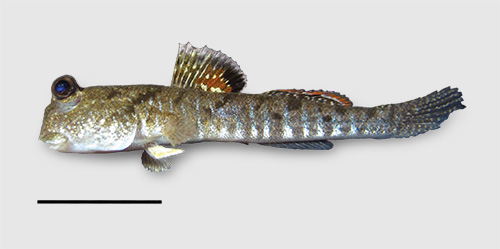|
Common names:
Singapore |
English |
Pusing mudskipper* |
Italy |
Italian |
perioftalmo Pusing* |
* proposed name
|

Periophthalmus pusing. Sumba Island, Indonesia;
lateral view, approximately 35 mm SL - live specimen (photo: Z. Jaafar, 2012)

Periophthalmus pusing. MZB 23015, female, 35.3 mm SL holotype (Jaafar, 2016).
Sumba Island, Indonesia;
lateral view;
the bar is 10 mm long
(photo: Sandra Raredon, 2016)
|
|
Synonyms:
Etymology:
'Periophthalmus' is a compound name from the Greek 'peri' (around), and 'ophthalmôn' (eye), which refers to the wide visual field of these species
'pusing' means 'giddy' in Indonesian, as it is believed that consuming these fishes causes headaches and giddiness (Jaafar et al., 2016)
|
Maximum recorded length:
37 mm SL (Jaafar et al., 2016)
Live colouration
(Jaafar et al., 2016):
ground colour greenish-brown to tan-brown on dorsum, silvery white to light beige on venter; multiple silvery vertical stripes on flanks, from the
pectoral-fin base to caudal peduncle, ventrally more evident; 7-8 dorsal dark brown saddle-like irregular bars may be visible. D1 with distal hyaline to silvery-white
margin, a broad black to dark brown inframarginal band, which is darker in the posterior portion, appearing as a spot, which aligns with the third saddle-like bar on trunk;
proximal portion of D1 with variable colouration, from greenish-yellow anteriorly and reddish-orange posteriorly with 2-3 rows of bright yellow flecks on interspinal membranes,
to entirely reddish orange with 1-2 rows of hyaline spots. D2 with distal hyaline margin, broad inframarginal reddish-orange band, another hyaline band below, and basal dusky
reddish-brown band, with 1-2 rows of small yellowish or hyaline spots. Caudal fin hyaline, with aligned series of dusky to brownish speckles along rays. Anal fin hyaline.
Pectoral-fin membranes hyaline, brownish along rays. Pelvic fins beige, dorsally whitish to yellowish
Colouration on preservation
(Jaafar et al., 2016):
ground colour dorsally and laterally beige to dusky brown, ventrally creamy beige, darker around eyes and snout; dark and irregular dorsal banded pattern
frequently visible. D1 with thin distal hyaline margin, broad inframarginal dark brown to black band, posteriorly more intensely pigmented, that appears as a spot,
which aligns with the third saddle-like bar on trunk; proximal to this band, there is a band which is light to dusky brown anteriorly and hyaline posteriorly;
whitish elongated spots in 2-3 rows on anterior spines. D2 with thin distal hyaline margin, broad inframarginal brown band, another hyaline band, and a basal dusky brown
band with 1-2 rows of spots on fin elements. Caudal fin hyaline with aligned series of dark speckles on rays. Pectoral fin hyaline on interradial membranes
and dusky light brown along fin elements. Pelvic fins white ventrally, dorsally dusky. Anal fin hyaline
Diagnosis (Jaafar et al., 2016):
D1 XI-XV; total D2 elements 11-13; total anal fin elements 11-13; longitudinal scale rows 42-54; pectoral-fin elements 10-12; predorsal scales (along dorsal midline) 14-19; pelvic fins completely separated, pelvic frenum
absent; D1 margin rounded; dorsal fins not connected by membrane; D1 with a black spot posteriorly, usually between 9th and ultimate spine; D1 taller than D2; interdorsal distance less than 1/2 the length of the first D1 spine; no elongated spines.
See Remarks for the discrimination between P. pusing and P. gracilis.
The genus is yet undefined by synapomorphies
Diet:
no scientific data available.
|






![]()